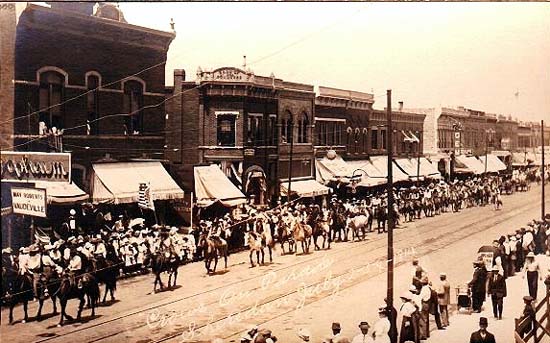
Crow Indians, Sheridan Stampede, July, 1914. Photo by G. Lumbard.
Rodeos have been a part of the American West since at least
1869 when a Fourth of July contest for the title "Champion Bronco Buster of the Plains" was held
in what is now Deer Trail, Colorado. By the end of the 19th Century local festivals featuring parades, rodeos,
county fairs had become a distinctively American phenomenon. Just about every small
down celebrated some local distinction, often portraying a fictionalized local legend. An example is
Lusk's "Legend of Rawhide," providing an explanation (of sorts) as to the naming of
Rawhide Buttes. Examples from elsewhere include New Orlean's Mardi Gras,
Tampa's Gasperilla and Pasadena's Rose Parade. The writer's wife came from a small town which
had its annual "Peanut Exposition." Almost all towns in Wyoming have had its festival or rodeo. The most
famous, Cheyenne's Frontier Days, was inspired by Greeley, Colorado's Potato Day. Cheyenne's was not, however,
the first in Wyoming. To that honor goes Lander which had its first rodeo in 1896, a year before
Cheyenne. Other rodeos, often held in conjunction with the Fourth of July and some of which are
gone now, included those of
Cody started in 1903, the Lusk Roundup, Jackson Frontier Days, Story Wild West
Rodeo, Moorcroft Frontier Days, Pinedale Roundup, the Casper Stampede and rodeos in Dubois, Shoshoni and
Encampment. In some other
parts of the country unfortunately such activities have declined as local citizenry either don't
have the time or have become too sophisticated for such activities. Fortunately, in Wyoming such traditions
are alive and well. Where else can one find something so elegant as Rawlins'
annual "Outhouse Race," held in July of each year? And in Sheridan fairs, parades, and rodeos with
cowboys and Indians have been conducted since at least the 1903 Industrial Fair.
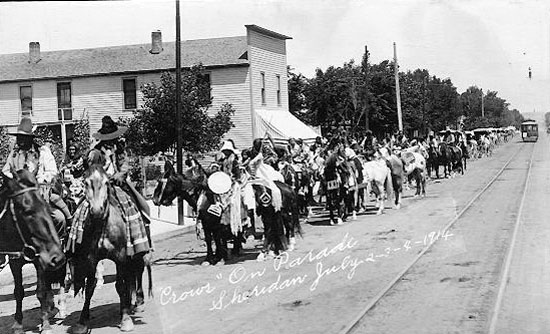
Sheridan Stampede Parade, 1914. Photo by G. Lumbard.
The trolly line was started in 1910 with a public subscription.
The fact that the rodeo and the Fourth of July are intertwined and represent the
epitome of the American cowboy is best illustrated by the legend of Pecos Bill first written of
by Edward O'Reilly in 1923 in the Century Magazine and later popularized by Iowa lawyer Harold W. Felton.
It will be recalled that Pecos Bill was reared by coyotes, was able to tame mountain lions and rattlesnakes, and had
a horse, "Widow-Maker" which nobody could ride but Bill. The centerpiece of the tale was, however, the
Fourth of July Rodeo at which Bill rode a cyclone, not any cyclone, but The Cyclone. The Cyclone
had become jealous of the attention given by the townspeople to the Rodeo and Bill and
decided to break things up. Bill's response was to rope The Cyclone and ride him -- the most bodacious
bronco busting rodeo there ever was.
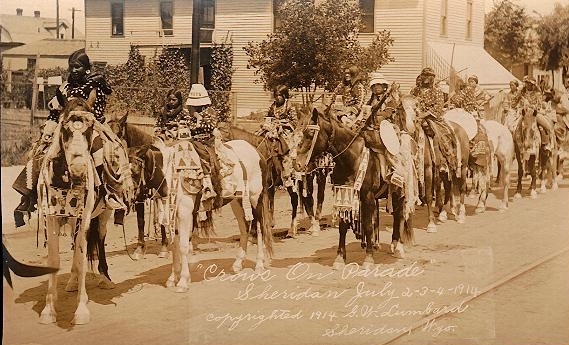
Sheridan Stampede Parade, 1914. Photo by G. Lumbard.
Crow Indians, whose reservation is located just north of the Montana line, have been
participating in fairs and rodeos in Sheridan since the Industrial Fair in 1903.
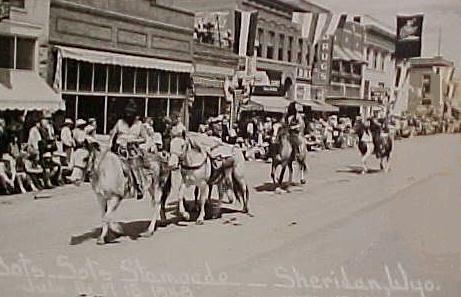
Crow Indians, Stampede, July,1948
Compare with photo at top of page. But before the reader
mistakenly believes that the Sheridan Parades are composed only of cowboys and
Indians, see next photo.
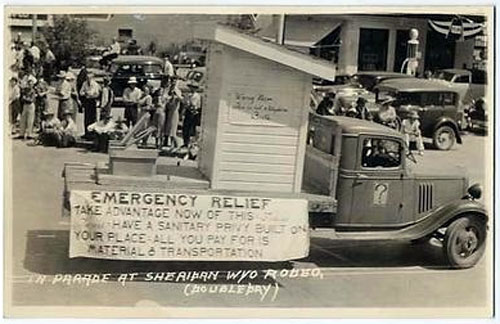
Parade, 1938. Photo by Ralph Doubleday.
Sheridan Photos continued on next page.
|